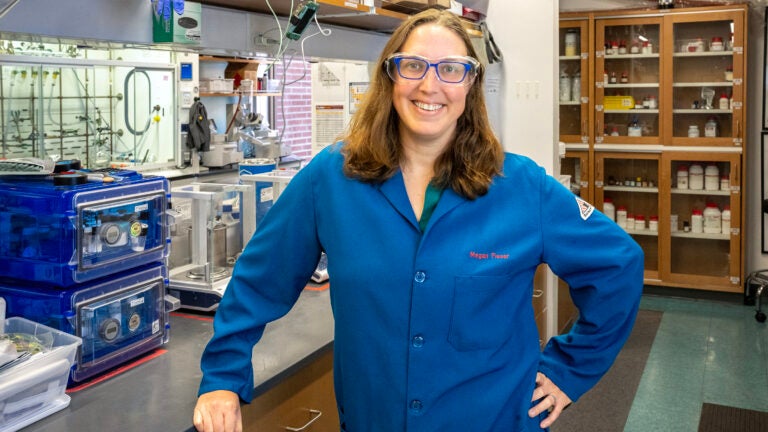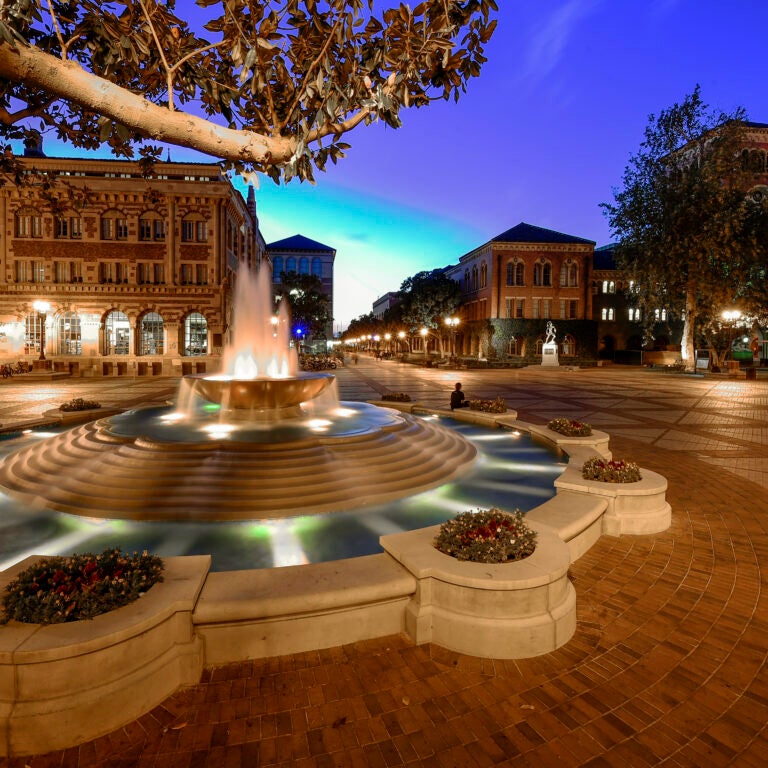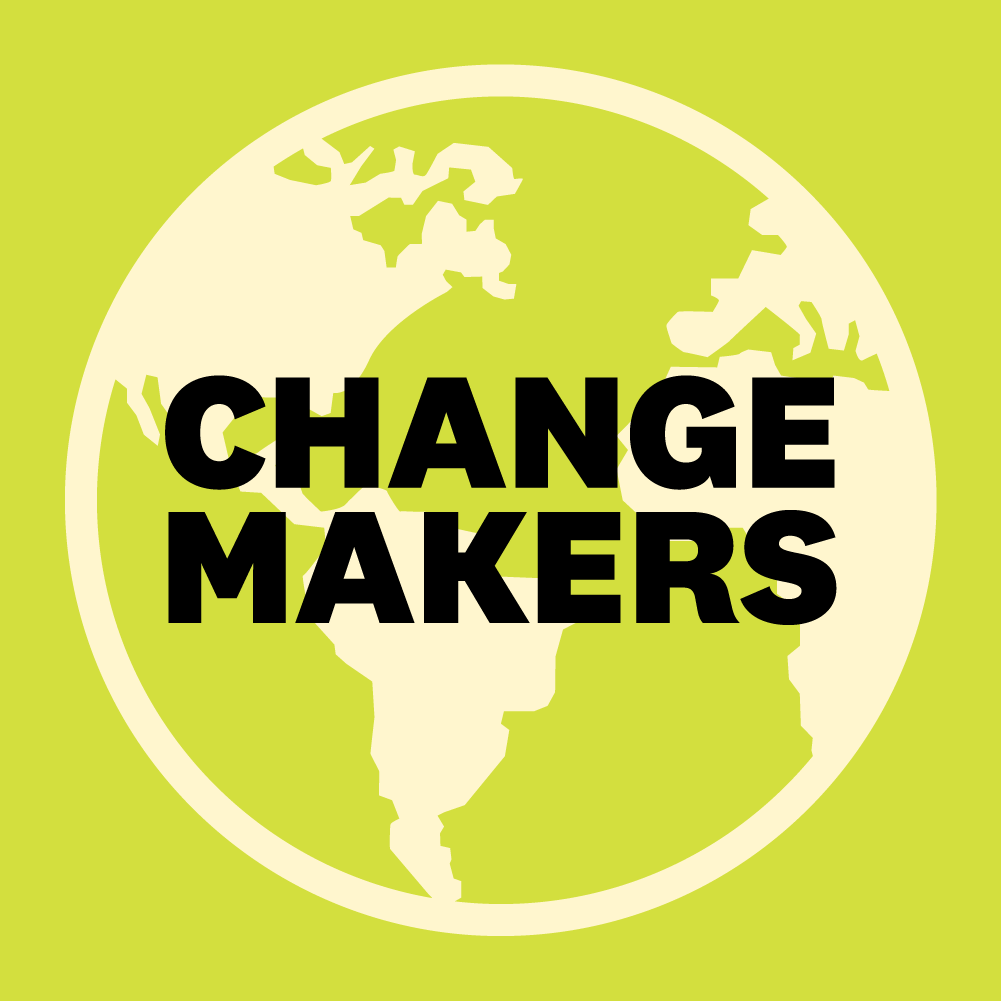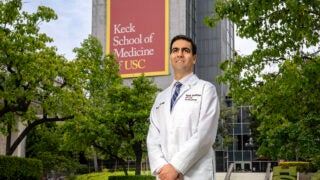
Megan Fieser, the Gabilan Assistant Professor of Chemistry, joined USC in 2018 and established the Fieser Lab the same year. (USC Photo/Gus Ruelas)
Working on a problematic plastic: Megan Fieser
EARTH MONTH: Megan Fieser, the Gabilan Assistant Professor of Chemistry at USC Dornsife, is working to resolve the vexing problem of plastic accumulating in our environment.
All April, Trojan Family Magazine will feature Trojans who have made a significant difference in sustainability at University of Southern California.
During the early days of the COVID-19 shutdown, Megan Fieser found herself with some unexpected time to think about reinvention and her research focus moving forward.
Since joining the USC Dornsife College of Letters, Arts and Sciences as the Gabilan Assistant Professor of Chemistry in 2018, Fieser has been investigating how degradable plastics can be alternatives for commercial, nondegradable materials.
During the pandemic pause, she decided to concentrate her research on polyvinyl chloride (PVC), the widely produced but toxic plastic. “I was trying to find an area that I could grow into my research program,” Fieser says. “PVC turned out to have that hook for me.”
New solutions for old materials
Repurposing PVC items into useful new materials that are less harmful to the environment became one of the goals at Fieser Lab USC, which Fieser founded in 2018. “There’s only a handful of people who spend time working on PVC because it is very difficult to work with,” she says — but that’s exactly why it needs attention, she adds.
PVC is used in a staggering array of everyday products, from IV drip bags in hospitals and vinyl records to kids’ meal toys, shower curtains, credit cards and construction materials like pipes and windows.
Yet its durability comes at a cost: It releases toxic and corrosive chemicals, doesn’t break down easily and is challenging to dispose of and recycle responsibly. “The core responsibility of my research group is to find ways to make materials that break down better or are more easily recyclable,” Fieser says.
At Fieser Lab USC, she and her students have developed a method to remove chlorine from PVC rapidly and in an environmentally friendly way — without producing corrosive gases. Fieser has submitted an application to patent the process, which would be a significant breakthrough toward identifying scalable, cost-effective methods for repurposing PVC waste in a commercially viable way.
It’s not easy to improve plastic sustainability, Fieser says. “Most of these plastics were really developed in the 1950s, and the way we make them hasn’t changed since,” she explains. “We found a very cheap and durable way of making those materials, but they weren’t designed to be recyclable or degradable.”
Setting up student success
Fieser knew at the age of 16 that she wanted to be a professor of chemistry. Now in her dream job, she strives to teach her students more than challenging science and how industrial chemistry works. She also wants them to have robust professional prospects.
Fieser is committed to making sure her students working in plastic sustainability can develop skills and expertise in inorganic, polymer and sustainable chemistry that sets them up for success in the job market. She often asks herself: “If my students want to work in the industry, how do I get them the right experience to work there? How do I get them exposed to the right things?”
Interdisciplinary minor on plastic circularity
With enhancing the professional prospects of students in mind, Fieser worked with her colleagues, chemistry professors Barry Thompson and Travis Williams, to develop an interdisciplinary minor on plastic circularity that was introduced in fall 2023. The minor, which includes a capstone course that Fieser designed, incorporates classes from environmental sciences, business, engineering and chemistry.
“They can get jobs that are part of the solution,” she says, “but it doesn’t have to be just as a scientist.”
More than a beach cleanup
Since 2019, Fieser has also organized regular local beach cleanups that have resulted in the collection of nearly 250,000 items to date. The events — held three times a year — not only aim to remove plastic waste but also track the types of plastic that are washing up on local shores.
“We ask people to count the items that they pick up,” Fieser says. “When you sit and pick up 1,000 items in two hours, you start to think about your consumer decisions and how you might make a change in the future. It’s the biggest impact — it’s a bit of a wake-up call.”
The next of the tri-annual cleanups will take place from 9:30-11:30 a.m. on June 8 at Alamitos Beach in Long Beach.




